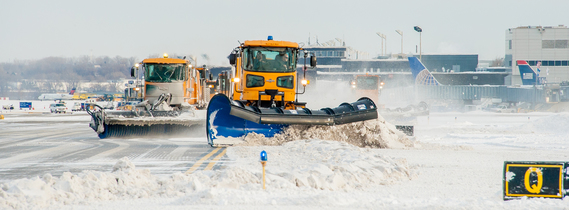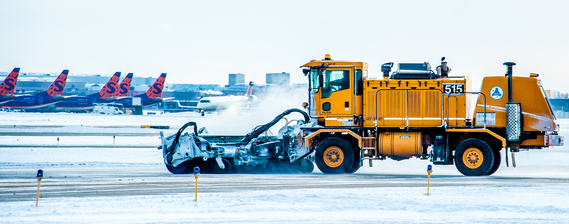 Dan Boivin, the chairman of the Metropolitan Airports Commission, was on hand at Amsterdam’s Schiphol Airport recently to mark Minneapolis-St. Paul International Airport’s signing of the Airports Sustainability Declaration.
The declaration, signed by 17 international airports during the 2016 Airports Going Green conference at Schiphol, emphasizes a commitment to sustainable operations through “collaboration, transparency, innovation and engagement.”
Pictured: Dan Boivin, MAC Commission Chairman.
American signatories of the declaration include MSP, the Chicago Department of Aviation, Dallas-Ft. Worth International Airport, New York-JFK, the Port of Portland, San Francisco International Airport and the Wayne County Airport Authority.
The full text of the declaration can be found here.
|
Winter weather may be off to a slow start this year, but the field maintenance crews that clear snow from the runways and the ramp at Minneapolis-St. Paul International Airport (MSP) have been ready since September.
Weather forecasts get constant attention at MSP and when they hint of a snowstorm, MSP’s team is planning for plowing long before the flakes fly.
Over the years, the snow-removal strategies for MSP have benefitted from modern equipment, refinements in plow routes and enhanced coordination between the parties that keep the airport running.
“It’s a collaboration,” said Jim Riley, the MAC’s manager of field maintenance/operations who oversees the snowplowing.
The end result is a snow-removal program designed with sustainability in mind, featuring safe, quick plowing while providing a minimal disruption of air traffic.
 MSP’s field maintenance division puts a manager in Airside Operations’ perch above Concourse E, where the team develops plans and monitors the snowplow crews’ progress.
One runway closure and snowplowing pattern on the airfield known as the “down-and-back” is the bread-and-butter route during most snowfalls, Riley said. A row of plows form a staggered “conga line” and make a push down and back on the runways determined to be a priority by the air traffic controllers, the airlines and the MAC.
The job can be completed in 20 minutes. That compares to the standard package of runway closures and snowplowing, which takes closer to 30 minutes, including certain feeder routes.
The shorter snow-clearing time means that aircraft that may be circling MSP, waiting for authorization to land, are now up in the air for a shorter amount of time, burning less fuel and ultimately keeping flights closer to their scheduled arrival and departure times.
Riley, who has been with the MAC for 34 years, said that the snow-plowing operation at MSP has evolved over time.
“Back in the day, we had half the equipment we have now,” he said, noting also that the number of flights -- and the number of runways – were both smaller back in the 1980s.
 The field maintenance division has garnered the coveted Balken Post award for snow removal more often than any other airport in North America. In recent years, the snow removal team also worked with a vendor to re-engineer a piece of agricultural equipment to efficiently remove snow from around the perimeter of the runway lights. That job previously took up to 14 individuals working by hand.
MSP’s field maintenance division has two teams. One focuses on the north side of the airfield, equipped with 22 pieces of snow-removal equipment, including plows, brooms, blowers and sanders.
The south side team has 12 pieces of similar equipment and plows an area that includes runway 17/35, which runs parallel to Cedar Avenue. There are also crews assigned to the ramp – the tarmac near the gates – on the north side of Terminal 1-Lindbergh, and another crew on the south.
Few large airports in the United States deal with snow as frequently as MSP does, and the airport’s staffing plan also sets it apart from its peer group. Snow-removal crews are kept at MSP for the duration of snowstorms, rotating out onto the runways for however long the storm lasts.
During snowstorms or icy conditions, a friction-testing machine is dispatched to the runways for a quick gauge of how much traction aircraft have during operations. If standards aren’t met, crews can respond with non-corrosive chemicals or snow-plowing.
The snow-plowing operation as a whole is based on collaborative decision-making, involving MSP’s airside operations, air traffic controllers and Delta Air Lines, said John Ostrom, MSP’s manager of airside operations.
Conference calls between the control tower, Delta and the airport are frequent during snow events, Ostrom said. “The tower will look at what the demand is. We provide the capacity through the runways,” he said.
Field maintenance is also part of that planning process, and crews then respond with whichever plowing package best meets the airport’s needs at that time.
“It truly is a collaboration,” Ostrom said.
|